ECU MAZDA MODEL 5 2006 User Guide
[x] Cancel search | Manufacturer: MAZDA, Model Year: 2006, Model line: MODEL 5, Model: MAZDA MODEL 5 2006Pages: 426, PDF Size: 7.18 MB
Page 44 of 426
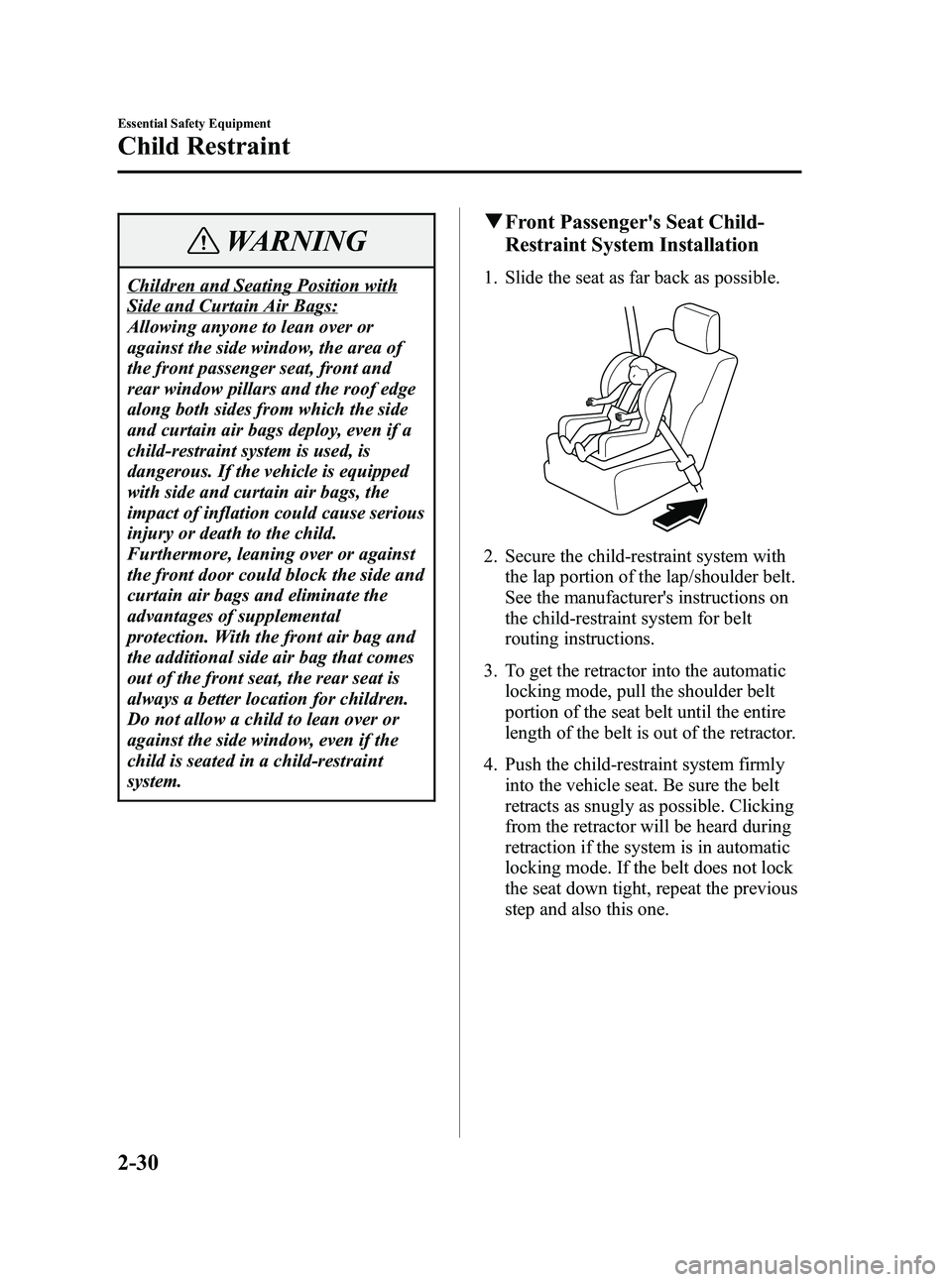
Black plate (44,1)
WARNING
Children and Seating Position with
Side and Curtain Air Bags:
Allowing anyone to lean over or
against the side window, the area of
the front passenger seat, front and
rear window pillars and the roof edge
along both sides from which the side
and curtain air bags deploy, even if a
child-restraint system is used, is
dangerous. If the vehicle is equipped
with side and curtain air bags, the
impact of inflation could cause serious
injury or death to the child.
Furthermore, leaning over or against
the front door could block the side and
curtain air bags and eliminate the
advantages of supplemental
protection. With the front air bag and
the additional side air bag that comes
out of the front seat, the rear seat is
always a better location for children.
Do not allow a child to lean over or
against the side window, even if the
child is seated in a child-restraint
system.
qFront Passenger's Seat Child-
Restraint System Installation
1. Slide the seat as far back as possible.
2. Secure the child-restraint system with
the lap portion of the lap/shoulder belt.
See the manufacturer's instructions on
the child-restraint system for belt
routing instructions.
3. To get the retractor into the automatic locking mode, pull the shoulder belt
portion of the seat belt until the entire
length of the belt is out of the retractor.
4. Push the child-restraint system firmly into the vehicle seat. Be sure the belt
retracts as snugly as possible. Clicking
from the retractor will be heard during
retraction if the system is in automatic
locking mode. If the belt does not lock
the seat down tight, repeat the previous
step and also this one.
2-30
Essential Safety Equipment
Child Restraint
Mazda3_8U55-EA-05G_Edition3 Page44
Tuesday, September 13 2005 10:40 AM
Form No.8U55-EA-05G
Page 47 of 426
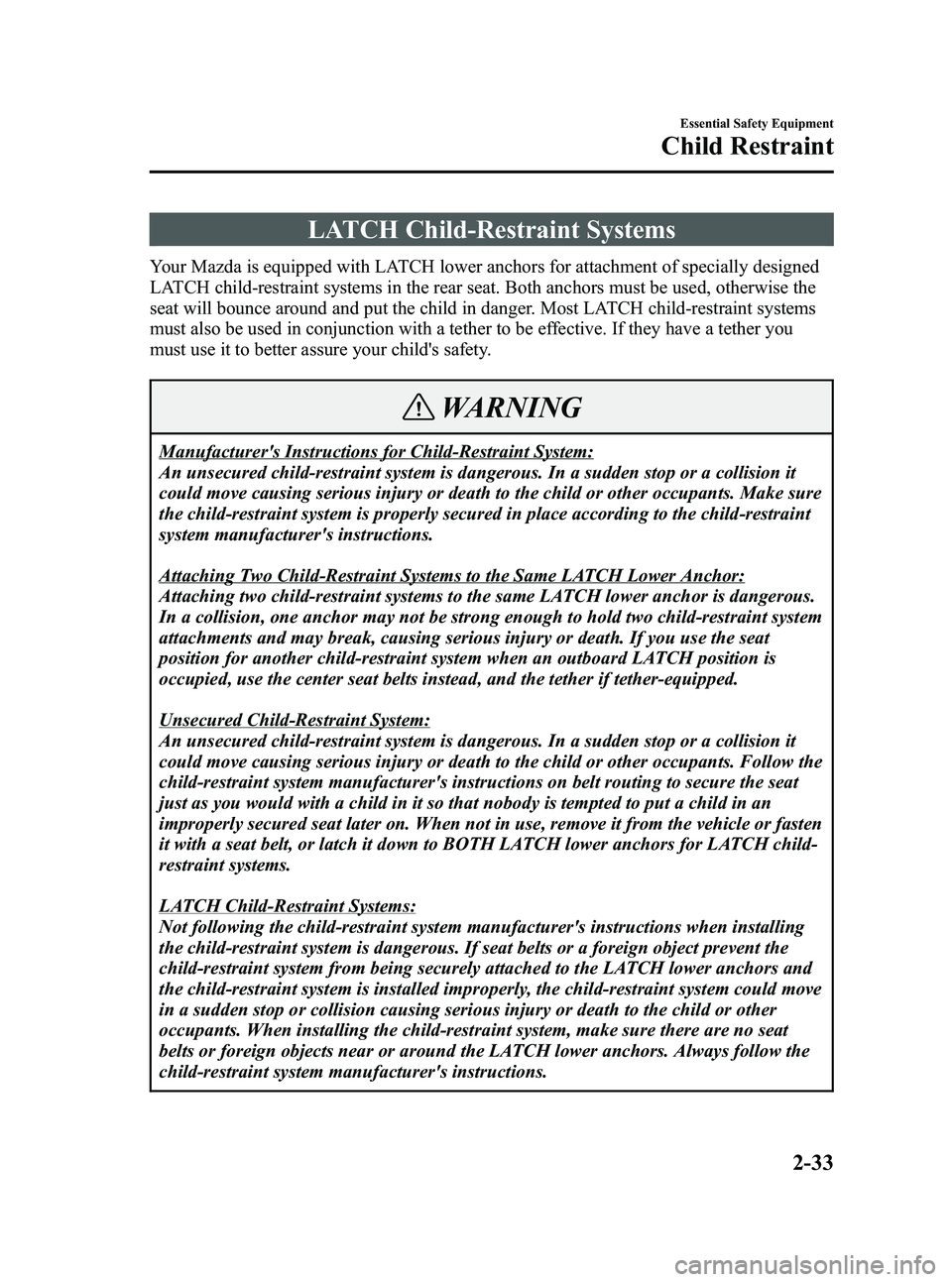
Black plate (47,1)
LATCH Child-Restraint Systems
Your Mazda is equipped with LATCH lower anchors for attachment of specially designed
LATCH child-restraint systems in the rear seat. Both anchors must be used, otherwise the
seat will bounce around and put the child in danger. Most LATCH child-restraint systems
must also be used in conjunction with a tether to be effective. If they have a tether you
must use it to better assure your child's safety.
WARNING
Manufacturer's Instructions for Child-Restraint System:
An unsecured child-restraint system is dangerous. In a sudden stop or a collision it
could move causing serious injury or death to the child or other occupants. Make sure
the child-restraint system is properly secured in place according to the child-restraint
system manufacturer's instructions.
Attaching Two Child-Restraint Systems to the Same LATCH Lower Anchor:
Attaching two child-restraint systems to the same LATCH lower anchor is dangerous.
In a collision, one anchor may not be strong enough to hold two child-restraint system
attachments and may break, causing serious injury or death. If you use the seat
position for another child-restraint system when an outboard LATCH position is
occupied, use the center seat belts instead, and the tether if tether-equipped.
Unsecured Child-Restraint System:
An unsecured child-restraint system is dangerous. In a sudden stop or a collision it
could move causing serious injury or death to the child or other occupants. Follow the
child-restraint system manufacturer's instructions on belt routing to secure the seat
just as you would with a child in it so that nobody is tempted to put a child in an
improperly secured seat later on. When not in use, remove it from the vehicle or fasten
it with a seat belt, or latch it down to BOTH LATCH lower anchors for LATCH child-
restraint systems.
LATCH Child-Restraint Systems:
Not following the child-restraint system manufacturer's instructions when installing
the child-restraint system is dangerous. If seat belts or a foreign object prevent the
child-restraint system from being securely attached to the LATCH lower anchors and
the child-restraint system is installed improperly, the child-restraint system could move
in a sudden stop or collision causing serious injury or death to the child or other
occupants. When installing the child-restraint system, make sure there are no seat
belts or foreign objects near or around the LATCH lower anchors. Always follow the
child-restraint system manufacturer's instructions.
Essential Safety Equipment
Child Restraint
2-33
Mazda3_8U55-EA-05G_Edition3 Page47
Tuesday, September 13 2005 10:40 AM
Form No.8U55-EA-05G
Page 48 of 426
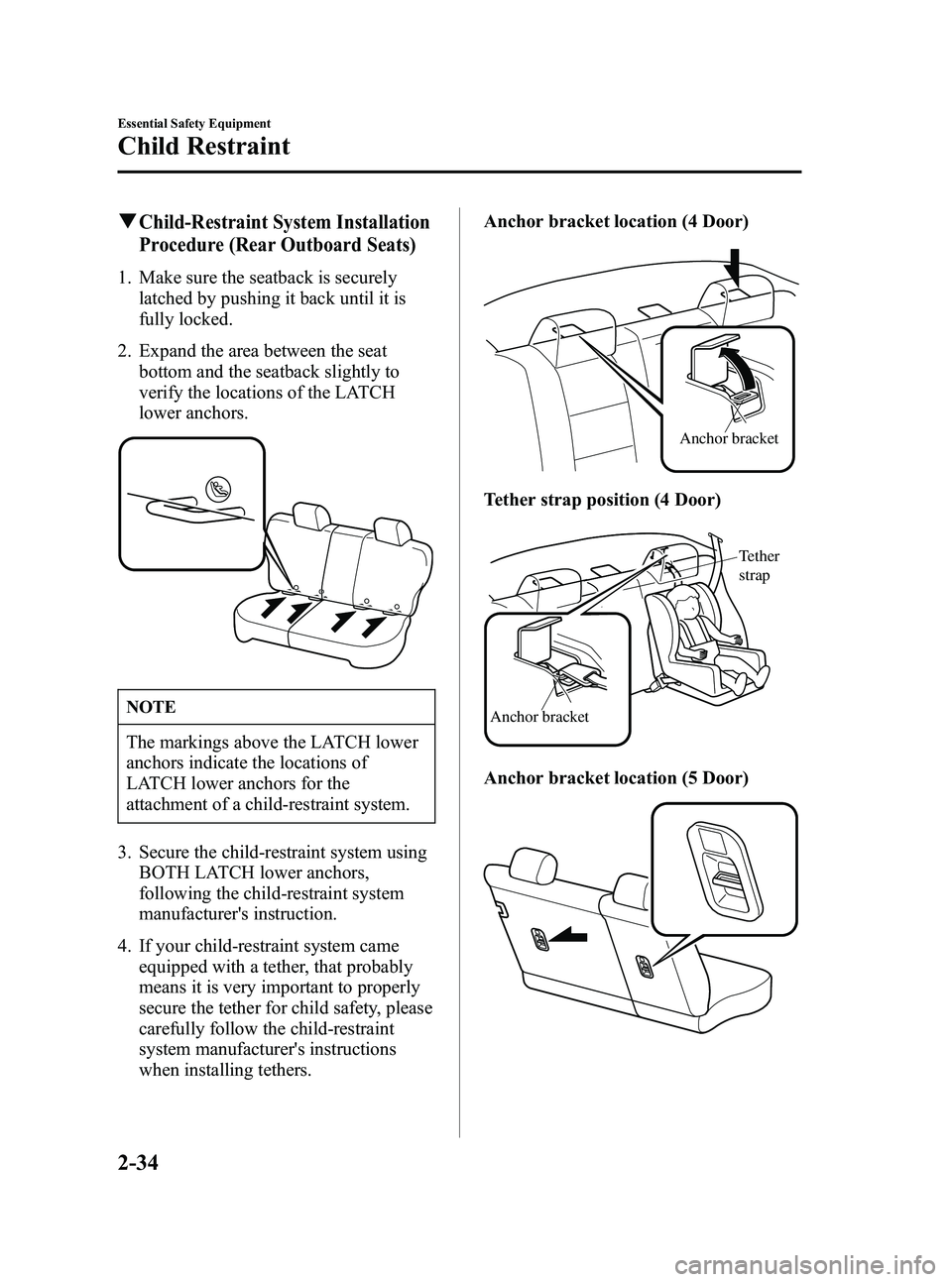
Black plate (48,1)
qChild-Restraint System Installation
Procedure (Rear Outboard Seats)
1. Make sure the seatback is securelylatched by pushing it back until it is
fully locked.
2. Expand the area between the seat bottom and the seatback slightly to
verify the locations of the LATCH
lower anchors.
NOTE
The markings above the LATCH lower
anchors indicate the locations of
LATCH lower anchors for the
attachment of a child-restraint system.
3. Secure the child-restraint system using BOTH LATCH lower anchors,
following the child-restraint system
manufacturer's instruction.
4. If your child-restraint system came equipped with a tether, that probably
means it is very important to properly
secure the tether for child safety, please
carefully follow the child-restraint
system manufacturer's instructions
when installing tethers. Anchor bracket location (4 Door)
Anchor bracket
Tether strap position (4 Door)
Anchor bracket
Tether
strap
Anchor bracket location (5 Door)
2-34
Essential Safety Equipment
Child Restraint
Mazda3_8U55-EA-05G_Edition3 Page48
Tuesday, September 13 2005 10:40 AM
Form No.8U55-EA-05G
Page 49 of 426
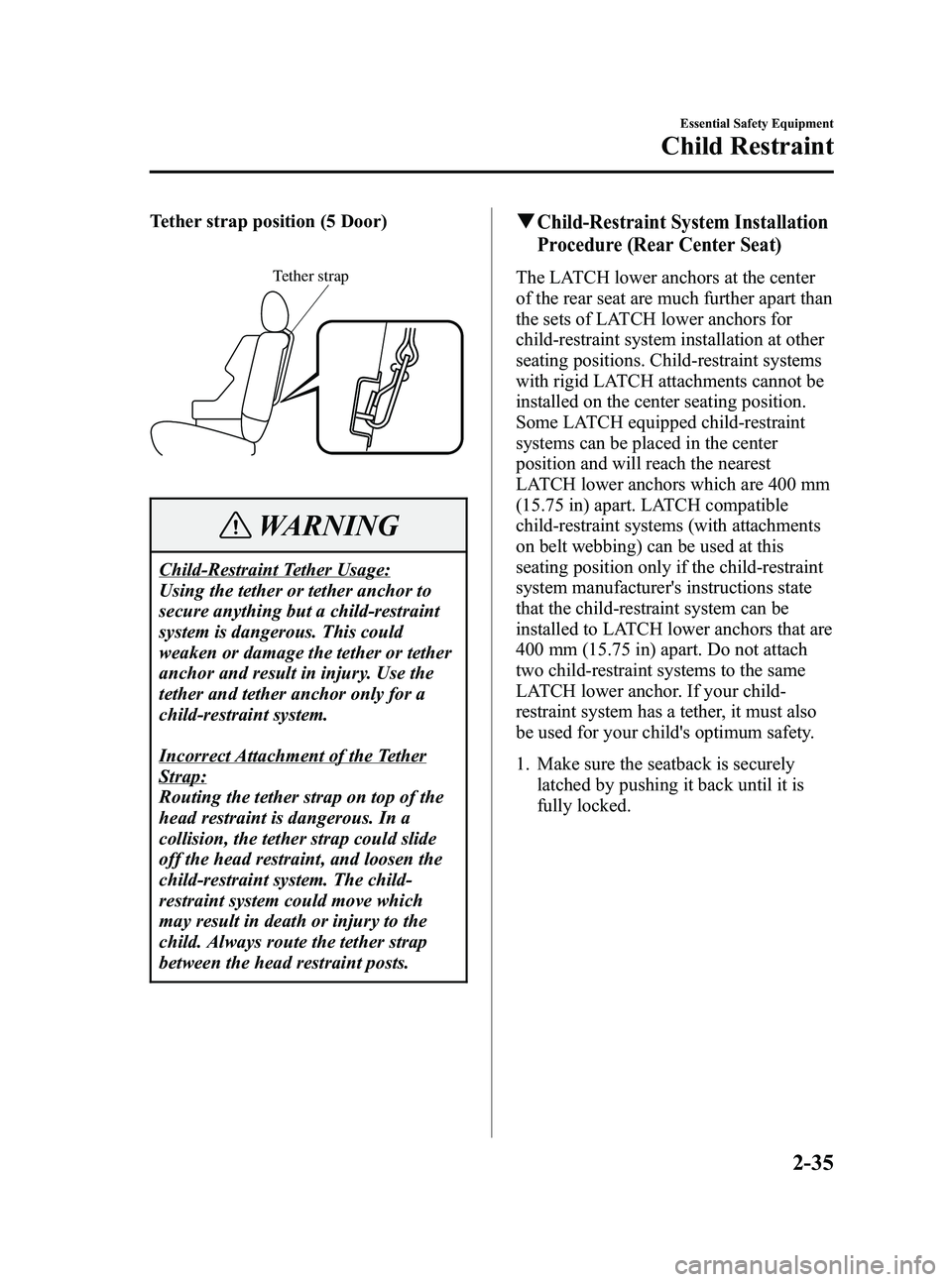
Black plate (49,1)
Tether strap position (5 Door)
Tether strap
WARNING
Child-Restraint Tether Usage:
Using the tether or tether anchor to
secure anything but a child-restraint
system is dangerous. This could
weaken or damage the tether or tether
anchor and result in injury. Use the
tether and tether anchor only for a
child-restraint system.
Incorrect Attachment of the Tether
Strap:
Routing the tether strap on top of the
head restraint is dangerous. In a
collision, the tether strap could slide
off the head restraint, and loosen the
child-restraint system. The child-
restraint system could move which
may result in death or injury to the
child. Always route the tether strap
between the head restraint posts.
qChild-Restraint System Installation
Procedure (Rear Center Seat)
The LATCH lower anchors at the center
of the rear seat are much further apart than
the sets of LATCH lower anchors for
child-restraint system installation at other
seating positions. Child-restraint systems
with rigid LATCH attachments cannot be
installed on the center seating position.
Some LATCH equipped child-restraint
systems can be placed in the center
position and will reach the nearest
LATCH lower anchors which are 400 mm
(15.75 in) apart. LATCH compatible
child-restraint systems (with attachments
on belt webbing) can be used at this
seating position only if the child-restraint
system manufacturer's instructions state
that the child-restraint system can be
installed to LATCH lower anchors that are
400 mm (15.75 in) apart. Do not attach
two child-restraint systems to the same
LATCH lower anchor. If your child-
restraint system has a tether, it must also
be used for your child's optimum safety.
1. Make sure the seatback is securelylatched by pushing it back until it is
fully locked.
Essential Safety Equipment
Child Restraint
2-35
Mazda3_8U55-EA-05G_Edition3 Page49
Tuesday, September 13 2005 10:40 AM
Form No.8U55-EA-05G
Page 50 of 426
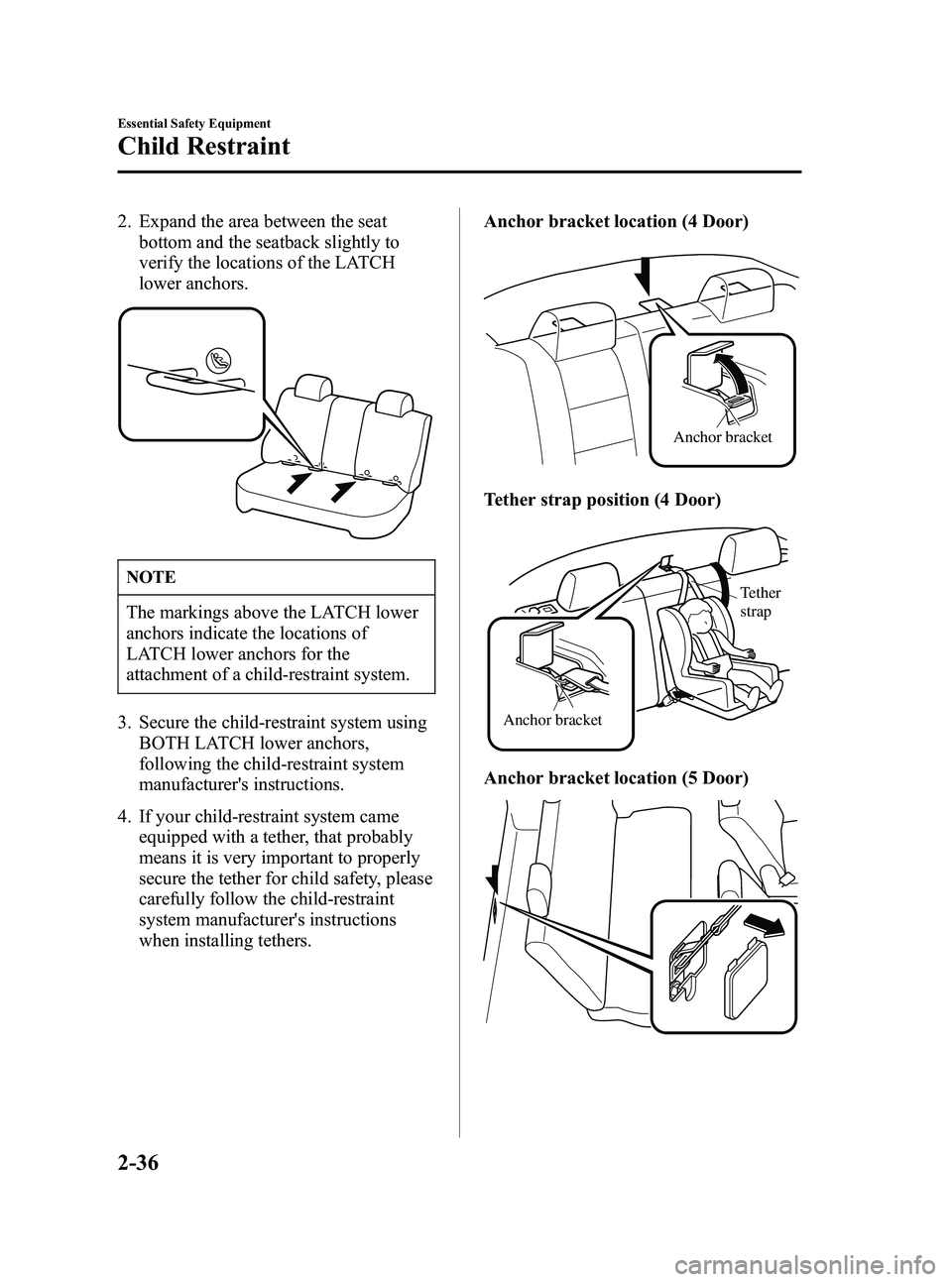
Black plate (50,1)
2. Expand the area between the seatbottom and the seatback slightly to
verify the locations of the LATCH
lower anchors.
NOTE
The markings above the LATCH lower
anchors indicate the locations of
LATCH lower anchors for the
attachment of a child-restraint system.
3. Secure the child-restraint system using BOTH LATCH lower anchors,
following the child-restraint system
manufacturer's instructions.
4. If your child-restraint system came equipped with a tether, that probably
means it is very important to properly
secure the tether for child safety, please
carefully follow the child-restraint
system manufacturer's instructions
when installing tethers. Anchor bracket location (4 Door)
Anchor bracket
Tether strap position (4 Door)
Anchor bracket
Tether
strap
Anchor bracket location (5 Door)
2-36
Essential Safety Equipment
Child Restraint
Mazda3_8U55-EA-05G_Edition3 Page50
Tuesday, September 13 2005 10:40 AM
Form No.8U55-EA-05G
Page 51 of 426

Black plate (51,1)
Tether strap position (5 Door)
Tether
strap
WARNING
Child-Restraint Tether Usage:
Using the tether or tether anchor to
secure anything but a child-restraint
system is dangerous. This could
weaken or damage the tether or tether
anchor and result in injury. Use the
tether and tether anchor only for a
child-restraint system.
Essential Safety Equipment
Child Restraint
2-37
Mazda3_8U55-EA-05G_Edition3 Page51
Tuesday, September 13 2005 10:40 AM
Form No.8U55-EA-05G
Page 53 of 426
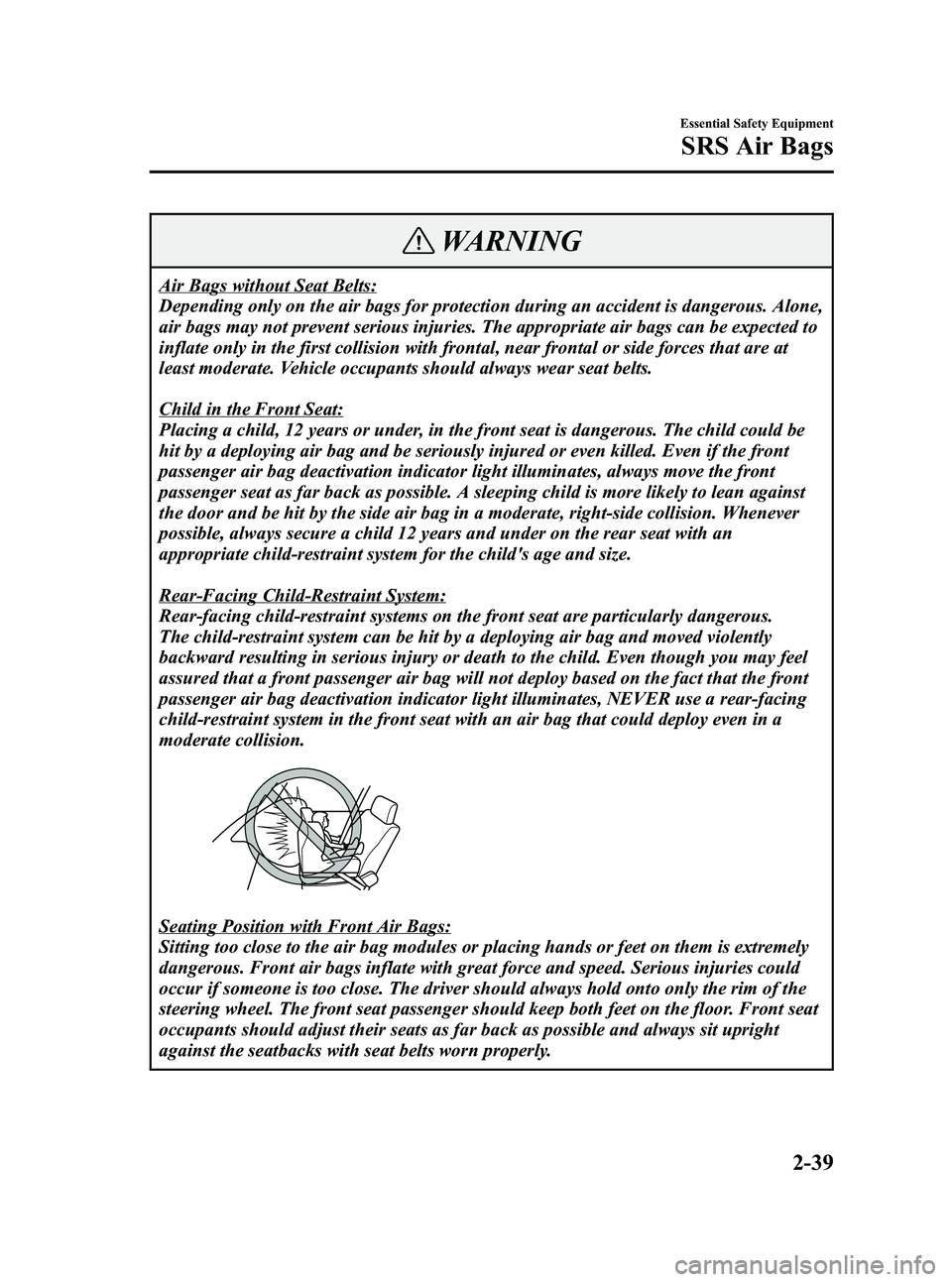
Black plate (53,1)
WARNING
Air Bags without Seat Belts:
Depending only on the air bags for protection during an accident is dangerous. Alone,
air bags may not prevent serious injuries. The appropriate air bags can be expected to
inflate only in the first collision with frontal, near frontal or side forces that are at
least moderate. Vehicle occupants should always wear seat belts.
Child in the Front Seat:
Placing a child, 12 years or under, in the front seat is dangerous. The child could be
hit by a deploying air bag and be seriously injured or even killed. Even if the front
passenger air bag deactivation indicator light illuminates, always move the front
passenger seat as far back as possible. A sleeping child is more likely to lean against
the door and be hit by the side air bag in a moderate, right-side collision. Whenever
possible, always secure a child 12 years and under on the rear seat with an
appropriate child-restraint system for the child's age and size.
Rear-Facing Child-Restraint System:
Rear-facing child-restraint systems on the front seat are particularly dangerous.
The child-restraint system can be hit by a deploying air bag and moved violently
backward resulting in serious injury or death to the child. Even though you may feel
assured that a front passenger air bag will not deploy based on the fact that the front
passenger air bag deactivation indicator light illuminates, NEVER use a rear-facing
child-restraint system in the front seat with an air bag that could deploy even in a
moderate collision.
Seating Position with Front Air Bags:
Sitting too close to the air bag modules or placing hands or feet on them is extremely
dangerous. Front air bags inflate with great force and speed. Serious injuries could
occur if someone is too close. The driver should always hold onto only the rim of the
steering wheel. The front seat passenger should keep both feet on the floor. Front seat
occupants should adjust their seats as far back as possible and always sit upright
against the seatbacks with seat belts worn properly.
Essential Safety Equipment
SRS Air Bags
2-39
Mazda3_8U55-EA-05G_Edition3 Page53
Tuesday, September 13 2005 10:40 AM
Form No.8U55-EA-05G
Page 62 of 426

Black plate (62,1)
WARNING
Increasing the Total Seated Weight on the Front Passenger Seat:
When an infant or small child sits on the front passenger seat, increasing the total
seated weight on the front passenger seat from the total seated weight of
approximately 30 kg (66 lb) is dangerous. The front passenger seat weight sensors will
detect the increased total seated weight, which could result in the unexpected
deployment of the front passenger front and side air bags and seat belt pretensioner
system in an accident and serious injury. Increasing the total seated weight on the
front passenger seat beyond the total seated weight of approximately 30 kg (66 lb)
could result in the front passenger front and side air bags and seat belt pretensioner
system deployment in an accident under the following conditions, for example:
lLuggage or other items are placed on the seat with the child in the child-restraint
system.
lA rear passenger or luggage push or pull down on the front passenger seatback.lA rear passenger steps on the front passenger seat rails with the feet.lLuggage or other items are placed on the seatback or hung on the head restraint.lThe seat is washed.lLiquids are spilled on the seat.lThe front passenger seat is moved backward, pushing into luggage or other items
placed behind it.
lThe front passenger seatback contacts the rear seat.lLuggage or other items are placed between the front passenger seat and driver seat.lAny accessories which might increase the total seated weight on the front passenger
seat are attached to the front passenger seat.
The front passenger front and side air bags and seat belt pretensioner systems will
deactivate if the total seated weight on the front passenger seat is close to 30 kg (66 lb)
and they will reactivate before the weight exceeds 42 kg (93 lb).
CAUTION
lTo assure proper deployment of the front air bag and to prevent damage to the sensors
in the front seat bottoms:
lDo not place sharp objects on the front seat bottoms or leave heavy luggage on
them.
lDo not spill any liquids on the front seats or under the front seats.
lTo allow the sensors to function properly, always perform the following:
lAdjust the front seats as far back as possible and always sit upright against the
seatbacks with seat belts worn properly.
lIf you place your child on the front passenger seat, secure the child-restraint system
properly and slide the front passenger seat as far back as possible (page 2-30).
2-48
Essential Safety Equipment
SRS Air Bags
Mazda3_8U55-EA-05G_Edition3 Page62
Tuesday, September 13 2005 10:40 AM
Form No.8U55-EA-05G
Page 63 of 426

Black plate (63,1)
NOTE
lThe system requires about 10 seconds to alternate between turning the front passenger
front and side air bags and seat belt pretensioner system on or off.
lThe front passenger air bag deactivation indicator light may illuminate repeatedly if
luggage or other items are put on the front passenger seat, or if the temperature of the
vehicle's interior changes suddenly.
lThe front passenger air bag deactivation indicator light may illuminate for 10 seconds
if the total seated weight on the front passenger seat changes.
lIf the front passenger air bag deactivation indicator light does not illuminate after
installing a child-restraint system on the front passenger seat, install the child-restraint
system on the rear seat and consult an Authorized Mazda Dealer as soon as possible.
Driver and front passenger buckle switches
The buckle switches on the front seat belts detect whether or not the front seat belts are
securely fastened and further control the deployment of the air bags.
qHow the Side and Curtain Air Bags Workí
When air bag crash sensors detect a side impact of greater than moderate force, an
electrical current is sent to the inflators.
Gases are produced to inflate the side and curtain air bags and after the inflation, the side
and curtain air bags quickly deflate.
The side and curtain air bags will function only once. After that, the side and curtain air
bags will not work again and must be replaced. Only an Authorized Mazda Dealer can
replace the systems.
The side and curtain air bags will deploy only on the
side the vehicle receives the force of the impact.
Essential Safety Equipment
SRS Air Bags
2-49íSome models.
Mazda3_8U55-EA-05G_Edition3 Page63
Tuesday, September 13 2005 10:40 AM
Form No.8U55-EA-05G
Page 71 of 426

Black plate (71,1)
3Knowing Your Mazda
Explanation of basic operations and controls; opening/closing and adjustment
of various parts.
Doors and Locks ........................................................................... 3-2Keys .......................................................................................... 3-2
Keyless Entry System
í............................................................ 3-3
Door Locks ............................................................................... 3-6
Liftgate (5 Door) ....................................................................... 3-9
Trunk Lid (4 Door) ................................................................. 3-12
Inside Trunk Release Lever (4 Door) ...................................... 3-15
Power Windows
í................................................................... 3-16
Fuel-Filler Lid and Cap ........................................................... 3-18
Hood ....................................................................................... 3-20
Moonroof
í............................................................................. 3-21
Security System ........................................................................... 3-23 Immobilizer System ................................................................ 3-23
Theft-Deterrent System
í........................................................ 3-26
Steering Wheel and Mirrors ...................................................... 3-28 Steering Wheel ........................................................................ 3-28
Mirrors .................................................................................... 3-28
3-1íSome models.
Mazda3_8U55-EA-05G_Edition3 Page71
Tuesday, September 13 2005 10:40 AM
Form No.8U55-EA-05G